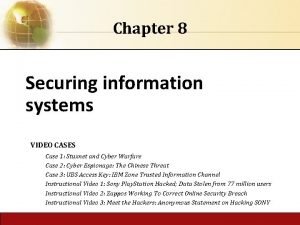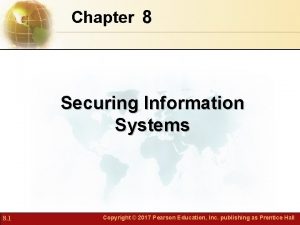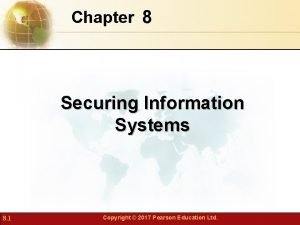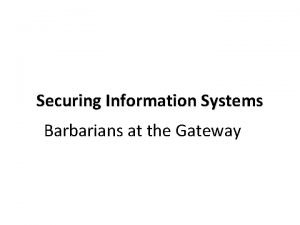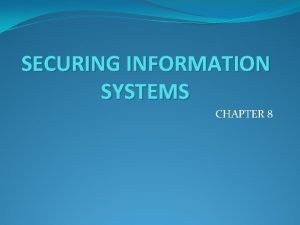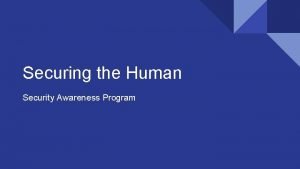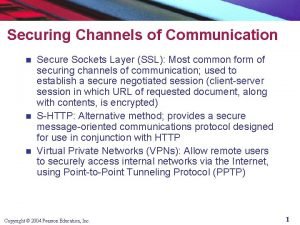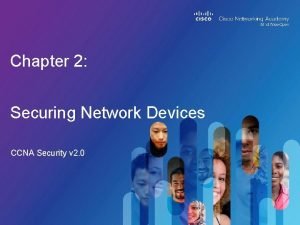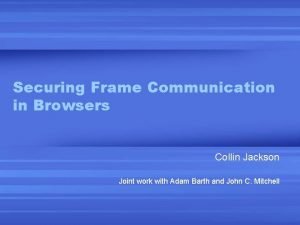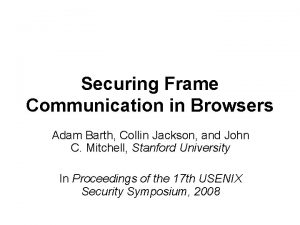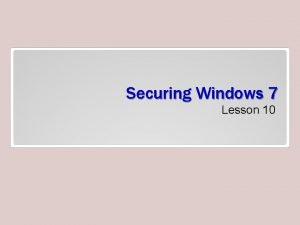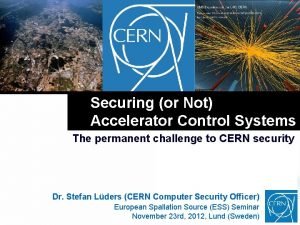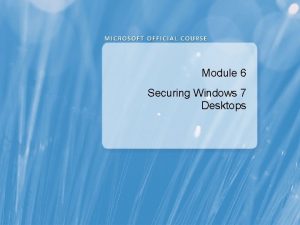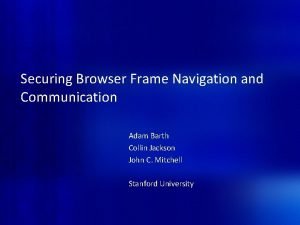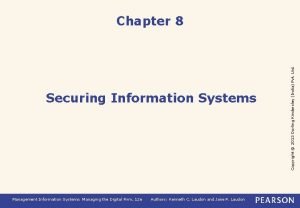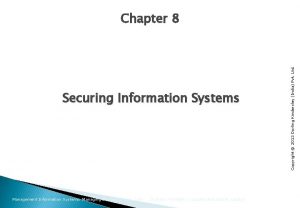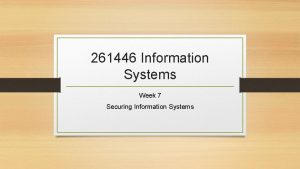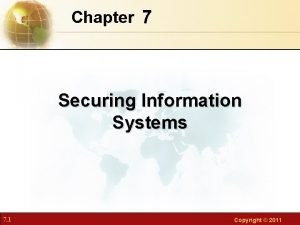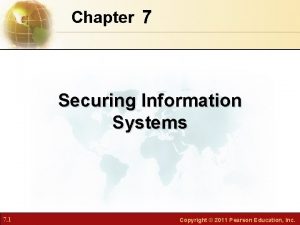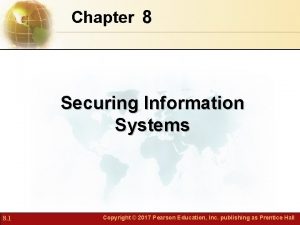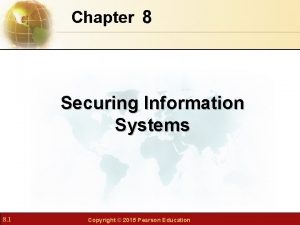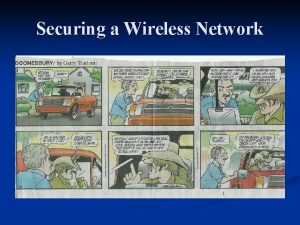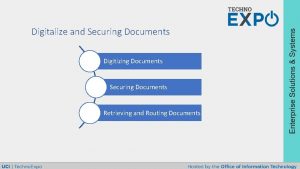Chapter 7 Securing Information Systems 7 1 Copyright


















- Slides: 18

Chapter 7 Securing Information Systems 7. 1 Copyright © 2011 Pearson Education, Inc. publishing as Prentice Hall

Essentials of Management Information Systems Chapter 7 Securing Information Systems System Vulnerability and Abuse • An unprotected computer connected to Internet may be disabled within seconds • Security: • Policies, procedures, and technical measures used to prevent unauthorized access, alteration, theft, or physical damage to information systems • Controls: • Methods, policies, and organizational procedures that ensure safety of organization’s assets; accuracy and reliability of its accounting records; and operational adherence to management standards 7. 2 Copyright © 2011 Pearson Education, Inc. publishing as Prentice Hall

Essentials of Management Information Systems Chapter 7 Securing Information Systems System Vulnerability and Abuse Why Systems Are Vulnerable • Hardware problems • Breakdowns, configuration errors, damage from improper use or crime • Software problems • Programming errors, installation errors, unauthorized changes • Disasters • Power failures, flood, fires, and so on • Use of networks and computers outside of firm’s control • E. g. , with domestic or offshore outsourcing vendors 7. 3 Copyright © 2011 Pearson Education, Inc. publishing as Prentice Hall

Essentials of Management Information Systems Chapter 7 Securing Information Systems System Vulnerability and Abuse Contemporary Security Challenges and Vulnerabilities Figure 7 -1 The architecture of a Web-based application typically includes a Web client, a server, and corporate information systems linked to databases. Each of these components presents security challenges and vulnerabilities. Floods, fires, power failures, and other electrical problems can cause disruptions at any point in the network. 7. 4 Copyright © 2011 Pearson Education, Inc. publishing as Prentice Hall

Essentials of Management Information Systems Chapter 7 Securing Information Systems System Vulnerability and Abuse • Internet vulnerabilities • Network open to anyone • Size of Internet means abuses can have wide impact • Use of fixed Internet addresses with permanent connections to Internet eases identification by hackers • E-mail attachments • E-mail used for transmitting trade secrets • IM messages lack security, can be easily intercepted 7. 5 Copyright © 2011 Pearson Education, Inc. publishing as Prentice Hall

Essentials of Management Information Systems Chapter 7 Securing Information Systems System Vulnerability and Abuse • Wireless security challenges • Radio frequency bands easy to scan • SSIDs (service set identifiers) • • Identify access points. Broadcast multiple times. • War driving • • Eavesdroppers drive by buildings and try to intercept network traffic When hacker gains access to SSID, has access to network’s resources • WEP (Wired Equivalent Privacy) • • • 7. 6 Security standard for 802. 11 Basic specification uses shared password for both users and access point Users often fail to use security features Copyright © 2011 Pearson Education, Inc. publishing as Prentice Hall

Essentials of Management Information Systems Chapter 7 Securing Information Systems System Vulnerability and Abuse Wi-Fi Security Challenges Many Wi-Fi networks can be penetrated easily by intruders using sniffer programs to obtain an address to access the resources of a network without authorization. Figure 7 -2 7. 7 Copyright © 2011 Pearson Education, Inc. publishing as Prentice Hall

Essentials of Management Information Systems Chapter 7 Securing Information Systems System Vulnerability and Abuse Malicious Software: Viruses, Worms, Trojan Horses, and Spyware • Malware • Viruses • Rogue software program that attaches itself to other software programs or data files in order to be executed • Worms • Independent computer programs that copy themselves from one computer to other computers over a network • Trojan horses • Software program that appears to be benign but then does something other than expected. 7. 8 Copyright © 2011 Pearson Education, Inc. publishing as Prentice Hall

Essentials of Management Information Systems Chapter 7 Securing Information Systems System Vulnerability and Abuse Malicious Software: Viruses, Worms, Trojan Horses, and Spyware • Malware (cont. ) • Spyware • Small programs install themselves surreptitiously on computers to monitor user Web surfing activity and serve up advertising • Key loggers • Record every keystroke on computer to steal serial numbers, passwords, launch Internet attacks 7. 9 Copyright © 2011 Pearson Education, Inc. publishing as Prentice Hall

Essentials of Management Information Systems Chapter 7 Securing Information Systems System Vulnerability and Abuse Hackers and Computer Crime • Hackers versus crackers • Activities include: • System intrusion • System damage • Cybervandalism • Intentional disruption, defacement, destruction of Web site or corporate information system 7. 10 Copyright © 2011 Pearson Education, Inc. publishing as Prentice Hall

Essentials of Management Information Systems Chapter 7 Securing Information Systems System Vulnerability and Abuse Hackers and Computer Crime • Spoofing • Misrepresenting oneself by using fake e-mail addresses or masquerading as someone else • Redirecting Web link to address different from intended one, with site masquerading as intended destination • Sniffer • Eavesdropping program that monitors information traveling over network • Enables hackers to steal proprietary information such as email, company files, and so on 7. 11 Copyright © 2011 Pearson Education, Inc. publishing as Prentice Hall

Essentials of Management Information Systems Chapter 7 Securing Information Systems System Vulnerability and Abuse Hackers and Computer Crime • Denial-of-service attacks (Do. S) • Flooding server with thousands of false requests to crash the network. • Distributed denial-of-service attacks (DDo. S) • Use of numerous computers to launch a Do. S • Botnets • Networks of “zombie” PCs infiltrated by bot malware 7. 12 Copyright © 2011 Pearson Education, Inc. publishing as Prentice Hall

Essentials of Management Information Systems Chapter 7 Securing Information Systems System Vulnerability and Abuse Hackers and Computer Crime • Computer crime • Defined as “any violations of criminal law that involve a knowledge of computer technology for their perpetration, investigation, or prosecution” • Computer may be target of crime: • Breaching confidentiality of protected computerized data • Accessing a computer system without authority • Computer may be instrument of crime: • Theft of trade secrets • Using e-mail for threats or harassment 7. 13 Copyright © 2011 Pearson Education, Inc. publishing as Prentice Hall

Essentials of Management Information Systems Chapter 7 Securing Information Systems System Vulnerability and Abuse Hackers and Computer Crime • Identity theft • Theft of personal information (social security id, driver’s license, or credit card numbers) to impersonate someone else • Phishing • Setting up fake Web sites or sending e-mail messages that look like legitimate businesses to ask users for confidential personal data • Evil twins • Wireless networks that pretend to offer trustworthy Wi-Fi connections to the Internet 7. 14 Copyright © 2011 Pearson Education, Inc. publishing as Prentice Hall

Essentials of Management Information Systems Chapter 7 Securing Information Systems System Vulnerability and Abuse Hackers and Computer Crime • Pharming • Redirects users to a bogus Web page, even when individual types correct Web page address into his or her browser • Click fraud • Occurs when individual or computer program fraudulently clicks on online ad without any intention of learning more about the advertiser or making a purchase 7. 15 Copyright © 2011 Pearson Education, Inc. publishing as Prentice Hall

Essentials of Management Information Systems Chapter 7 Securing Information Systems System Vulnerability and Abuse Internal Threats: Employees • Security threats often originate inside an organization. • Inside knowledge • Sloppy security procedures • User lack of knowledge • Social engineering: • Tricking employees into revealing their passwords by pretending to be legitimate members of the company in need of information 7. 16 Copyright © 2011 Pearson Education, Inc. publishing as Prentice Hall

Essentials of Management Information Systems Chapter 7 Securing Information Systems System Vulnerability and Abuse Software Vulnerability • Commercial software contains flaws that create security vulnerabilities. • Hidden bugs (program code defects) • Zero defects cannot be achieved because complete testing is not possible with large programs • Flaws can open networks to intruders • Patches • Vendors release small pieces of software to repair flaws. • However, amount of software in use can mean exploits created faster than patches can be released and implemented. 7. 17 Copyright © 2011 Pearson Education, Inc. publishing as Prentice Hall

All rights reserved. No part of this publication may be reproduced, stored in a retrieval system, or transmitted, in any form or by any means, electronic, mechanical, photocopying, recording, or otherwise, without the prior written permission of the publisher. Printed in the United States of America. Copyright © 2011 Pearson Education, Inc. Publishing as Prentice Hall 7. 18 Copyright © 2011 Pearson Education, Inc. publishing as Prentice Hall
 Securing information systems
Securing information systems Chapter 8 securing information systems
Chapter 8 securing information systems Securing information systems
Securing information systems Chapter 8 securing information systems
Chapter 8 securing information systems Chapter 8 securing information systems
Chapter 8 securing information systems Securing information systems
Securing information systems Securing information systems summary
Securing information systems summary Chapter 8 securing the republic summary
Chapter 8 securing the republic summary Securing the human
Securing the human The most common form of securing channel through
The most common form of securing channel through Securing network devices
Securing network devices Guninski attack
Guninski attack Adam secure browser
Adam secure browser Securing windows 7
Securing windows 7 Securing
Securing Securing windows 7
Securing windows 7 The capes used for shampooing wet hair sculpting
The capes used for shampooing wet hair sculpting Securing the northwest territory
Securing the northwest territory Securing frame communication in browsers
Securing frame communication in browsers


